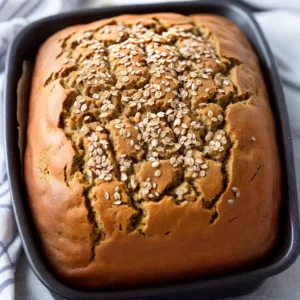How to Blanch Tomatoes
Are you ready to learn how to blanch tomatoes like a master chef?
Blanching tomatoes is a simple process that makes it easy to peel them. Start by washing the tomatoes under cold water and removing any soft or rotten spots. Trim the stems using a small knife or a stem remover. Cut a 1-inch “x” into the bottom of each tomato. Next, bring a large pot of water to a boil and prepare an ice water bath with a bowl of water and ice. Submerge the tomatoes in the boiling water for 30 to 60 seconds until the skin starts to peel back. Use a slotted spoon to remove the tomatoes and place them in the ice water bath for 30 seconds to 1 minute. Peel away the skin starting from the “x” immediately after drying. Finally, you can freeze the peeled tomatoes by placing them on cookie sheets and then transferring them to freezer bags. They can be stored in the freezer for up to 8 months.
Key Takeaways – How to Blanch Tomatoes:
- Blanching tomatoes involves a simple process to make peeling easy and efficient.
- Wash the tomatoes, remove any soft or rotten spots, and trim the stems.
- Make small incisions at the bottom of each tomato for effective blanching.
- Boil water and prepare an ice water bath for the blanching process.
- Submerge the tomatoes in boiling water and transfer them to the ice water bath.
- Peel the blanched tomatoes easily by starting at the incision.
- Freeze the peeled tomatoes for future use by placing them on cookie sheets and transferring to freezer bags.
- Store the frozen tomatoes in the freezer for up to 8 months.
Now that you have learned the step-by-step guide to blanching tomatoes, you can easily enjoy the benefits of peeled tomatoes in your cooking. Whether you are making sauces, soups, or other tomato-based dishes, blanching will save you time and effort. Give it a try and elevate your culinary skills today!
Why Blanching Tomatoes is Important
Blanching tomatoes is an essential technique in the culinary world, as it helps achieve a desirable texture and makes peeling the skin effortless. When tomatoes are blanched, their skins soften and loosen, allowing for easy removal. This is particularly useful when using tomatoes in recipes that require a smooth texture, such as sauces, soups, or salsas. Additionally, blanching tomatoes helps to enhance their flavor, making them more enjoyable to eat.
Blanching tomatoes also plays a crucial role in food preservation. By blanching and peeling tomatoes before freezing them, you can extend their shelf life and preserve their quality. The blanching process halts enzyme activity that can cause the tomatoes to spoil, ensuring that they remain fresh and flavorful for months to come.
Furthermore, blanching tomatoes allows for better incorporation of the fruit into various dishes. The removal of the skin provides a smooth and consistent texture, making it easier to blend or puree the tomatoes. This opens up a world of culinary possibilities, from creating vibrant tomato sauces to adding depth to stews and casseroles.

- Easy peeling of the skin
- Improved texture for sauces and soups
- Enhanced flavor
- Extended shelf life
- Smooth and consistent texture for blending and pureeing
In conclusion, blanching tomatoes is an essential technique that brings numerous benefits to your culinary endeavors. Whether you’re aiming for a velvety tomato soup or a rich pasta sauce, blanching will help you achieve the desired texture and unlock the full flavor potential of this versatile fruit.
Preparing the Tomatoes
Before blanching tomatoes, it’s crucial to properly prepare them for the process. This ensures that you achieve the best results and make the peeling process easier. Here are the steps to follow:
- Start by washing the tomatoes under cold water. This helps remove any dirt or debris on the surface.
- Inspect the tomatoes and remove any soft or rotten spots. These areas can affect the quality of the blanched tomatoes.
- Using a small knife or a stem remover, trim the stems of the tomatoes. This step ensures that the blanching process reaches the entire tomato evenly.
Once you’ve completed these preparation steps, your tomatoes are ready for blanching. Take care to handle the tomatoes gently to avoid bruising or damaging them.
Preparing the Tomatoes
Before blanching tomatoes, it’s crucial to properly prepare them for the process. This ensures that you achieve the best results and make the peeling process easier. Here are the steps to follow:
- Start by washing the tomatoes under cold water. This helps remove any dirt or debris on the surface.
- Inspect the tomatoes and remove any soft or rotten spots. These areas can affect the quality of the blanched tomatoes.
- Using a small knife or a stem remover, trim the stems of the tomatoes. This step ensures that the blanching process reaches the entire tomato evenly.
Once you’ve completed these preparation steps, your tomatoes are ready for blanching. Take care to handle the tomatoes gently to avoid bruising or damaging them.
| Tip: | To make the trimming process easier, you can use a stem remover tool like the one shown below: |
|---|---|
Making Incisions
To ensure the tomatoes blanch properly, it’s important to make small incisions in the skin. This step allows the hot water to penetrate the tomatoes and loosen the skin, making it easier to peel off later. Here’s a step-by-step guide on how to make the incisions:
- Start by washing the tomatoes under cold water to remove any dirt or debris.
- Inspect each tomato and remove any soft or rotten spots using a small knife.
- Using a sharp knife or a stem remover, trim the stems of the tomatoes.
- Hold a tomato gently in one hand and make a shallow “x” incision on the bottom, opposite the stem side. The incision should be about 1-inch long, piercing through the skin but not too deep into the flesh.
- Repeat this process for each tomato, ensuring that the incisions are even and consistent.
Making these small incisions will help the tomatoes blanch evenly, resulting in easy-to-peel tomatoes that are perfect for all your culinary needs.
“Blanching the tomatoes with small incisions not only makes peeling easier but also helps in maintaining the texture and flavor of the tomatoes,” says Chef Julia. “The hot water can fully penetrate the tomatoes and release their natural sweetness. It’s a crucial step in many tomato-based recipes.”
Now that you’ve made the necessary incisions, you’re ready to move on to the next step in the blanching process.
Boiling Water and Preparing an Ice Bath
Now that the tomatoes are ready, let’s move on to boiling water and preparing an ice bath. These two elements are crucial in the blanching process as they help to loosen the skin of the tomatoes and stop the cooking process, making it easier to peel them later on.
To begin, fill a large pot with water and bring it to a rolling boil. You want enough water to fully submerge the tomatoes. While the water is heating up, prepare an ice water bath in a separate bowl or sink filled with cold water and ice cubes. This ice bath will quickly cool down the tomatoes and halt the cooking process.
Once the water is boiling and the ice bath is ready, you’re all set to blanch the tomatoes. Remember to use a slotted spoon or tongs to transfer the tomatoes from the boiling water to the ice water bath. This will ensure that you don’t burn yourself and that the tomatoes are fully immersed in the cold water. Let them sit in the ice bath for about 30 seconds to 1 minute.

After their refreshing ice bath, the tomatoes are now ready to be peeled. The blanching process has softened the skin, making it easy to remove. Start by drying the tomatoes with a clean kitchen towel or paper towel. This will make it easier to grip the skin and prevent any slipping.
Now you can easily peel away the skin starting from the “x” that you made earlier. The skin should easily slip off, exposing the juicy and tender flesh of the tomatoes. If you encounter any stubborn areas, simply use a paring knife to remove them.
Finally, if you have more tomatoes than you can use immediately, you can freeze the peeled tomatoes for future use. Place them on cookie sheets in a single layer and freeze them until they are firm. Then, transfer them to freezer bags or containers, making sure to remove any excess air to prevent freezer burn. They can be stored in the freezer for up to 8 months, ready to be thawed and used in your favorite recipes.
Blanching the Tomatoes
It’s time to blanch the tomatoes and achieve that perfect peelable skin. Blanching is a simple yet effective technique that makes peeling tomatoes a breeze. With just a few steps, you can prepare your tomatoes for a variety of recipes and enjoy their vibrant flavors.
To begin, start by washing the tomatoes under cold water to remove any dirt or debris. Check for any soft or rotten spots and remove them with a small knife. Trim the stems using a stem remover or a small knife, ensuring a clean and neat appearance.
To facilitate the peeling process, make a small “x” incision at the bottom of each tomato. This will allow the skin to easily separate from the flesh during blanching. Now, bring a large pot of water to a rolling boil and prepare an ice water bath by filling a bowl with cold water and adding ice cubes.
Using a slotted spoon, carefully lower the tomatoes into the boiling water, submerging them for about 30 to 60 seconds. You’ll notice the skin starting to peel back. Promptly transfer the blanched tomatoes into the ice water bath to stop the cooking process. Let them sit for 30 seconds to 1 minute to cool down and firm up.
Now, remove the tomatoes from the ice water bath and pat them dry with a clean towel. The skin will be loose and easy to peel. Starting from the “x” incision at the bottom, gently peel away the skin, revealing the beautifully blanched flesh beneath.
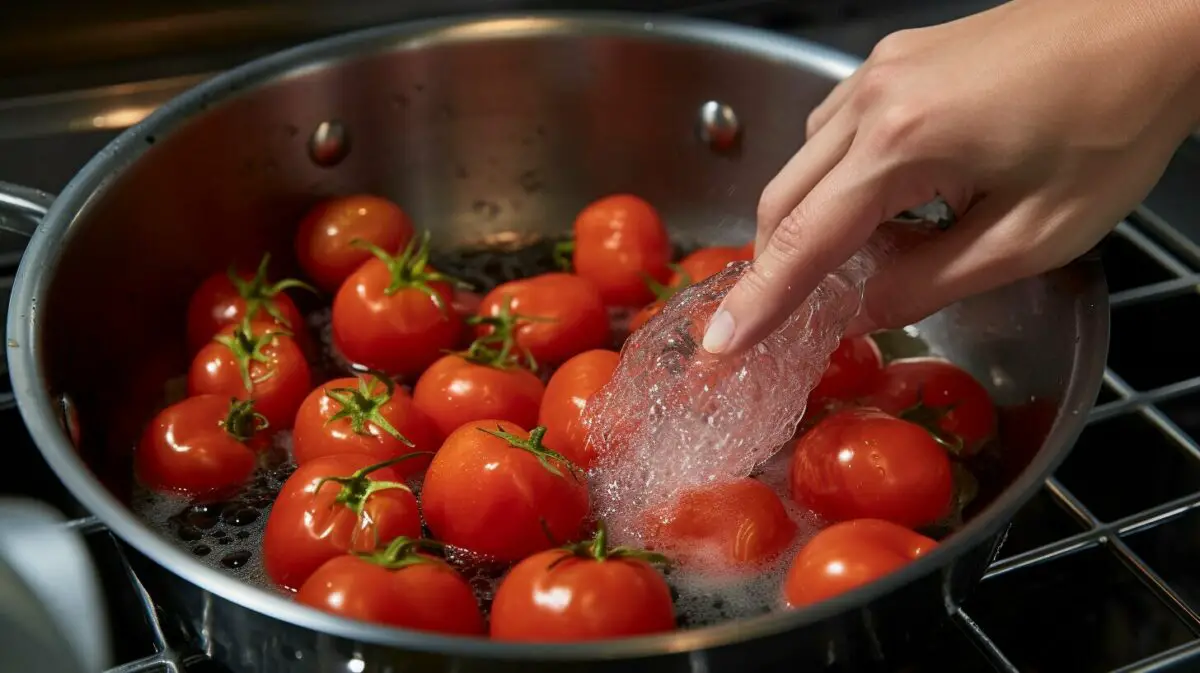
| Benefits of Blanching Tomatoes: |
|---|
| 1. Easy peeling: Blanching loosens the skin, making it effortless to remove. |
| 2. Enhanced flavor: By blanching, the natural flavors of tomatoes become more concentrated. |
| 3. Versatility: Blanched tomatoes can be used in various recipes like sauces, soups, or stews. |
| 4. Texture improvement: Blanching helps to soften the tomatoes for a smoother texture in dishes. |
Now that you’ve mastered the art of blanching tomatoes, you can explore the numerous culinary possibilities they offer. Whether you use them in a classic marinara sauce or add them to a refreshing gazpacho, blanched tomatoes will elevate your dishes with their vibrant flavor and smooth texture.
Transferring to an Ice Bath
Once the tomatoes have been adequately blanched, it’s crucial to transfer them to an ice bath promptly. This step not only stops the cooking process but also helps in loosening the skin, making it easier to peel off. The rapid change in temperature from hot to cold causes the tomatoes to contract, resulting in the skin separating from the flesh.
To create an ice water bath, simply fill a large bowl with cold water and add ice cubes. The ice water bath should be deep enough to fully submerge the blanched tomatoes. The cold temperature of the ice bath helps to cool down the tomatoes quickly, preventing them from overcooking and maintaining their vibrant color.
Using a slotted spoon or a pair of tongs, carefully transfer the blanched tomatoes from the boiling water to the ice water bath. Allow the tomatoes to sit in the ice bath for 30 seconds to 1 minute. This short soak in the icy water further aids in loosening the skin and stopping the cooking process.
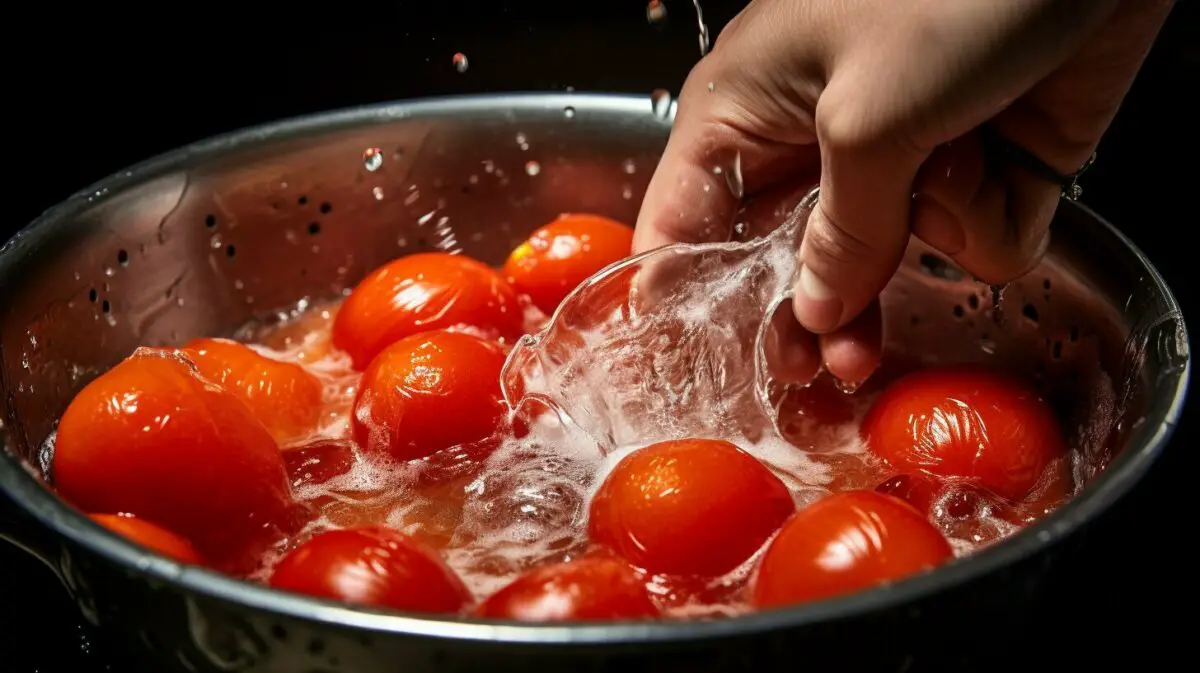
After the tomatoes have been in the ice water bath for the recommended time, you can remove them and proceed to the next step of peeling. The blanched tomatoes, now cooled and ready for peeling, are a vital ingredient in various recipes. Their skin will easily slip off, revealing the tender and juicy flesh underneath.
Expert Tip:
For easier peeling, gently squeeze the blanched tomatoes, and the skin will start to loosen even more. This trick works especially well with ripe tomatoes.
Peeling the Tomatoes
With the right technique, peeling blanched tomatoes is a breeze. After you have blanched the tomatoes and transferred them to the ice water bath, the skin will start to peel back, making it easy to remove. Simply hold the tomato gently in your hand and use your fingers or a small knife to peel away the skin. Start from the “x” that was cut at the bottom of the tomato and gently pull the skin away in a downward motion. The blanching process makes the skin loose and pliable, so it should come off effortlessly.
To make the peeling process even smoother, make sure to thoroughly dry the tomatoes after removing them from the ice water bath. Excess moisture can make the skin slippery and harder to grip. Use a clean kitchen towel or paper towels to pat the tomatoes dry before peeling them.
Once the tomatoes are peeled, you can use them in your favorite recipes or freeze them for later use. Enjoy the convenience of having peeled tomatoes readily available for all your culinary creations!
img src=”https://seo-writing.ai/32_6.png” alt=”peeling tomatoes” />
| Tips for Easy Tomato Peeling |
|---|
| 1. Use ripe tomatoes for the best results. The riper the tomato, the easier it will be to peel. |
| 2. Make sure to cut a proper “x” at the bottom of each tomato. This will help the skin peel away more easily. |
| 3. Take your time when peeling the tomatoes and be gentle to avoid damaging the flesh. |
| 4. If you encounter any resistant spots while peeling, use a small knife to gently remove them. |
Freezing the Tomatoes
Don’t let those perfectly blanched and peeled tomatoes go to waste – learn how to freeze them for later use. Freezing tomatoes is a great way to preserve their freshness and flavor, ensuring you can enjoy them in your favorite recipes all year round.
To freeze the peeled tomatoes, start by placing them on a cookie sheet in a single layer. This prevents them from sticking together and makes it easier to portion them later. Make sure the tomatoes are completely dry before placing them on the cookie sheet.
Once the tomatoes are on the cookie sheet, transfer it to the freezer. Allow the tomatoes to freeze completely, which usually takes about 2 to 3 hours. Once frozen, transfer the tomatoes to freezer-safe bags or containers. Make sure to label the bags or containers with the date so you can keep track of their freshness.
Frozen tomatoes can be stored in the freezer for up to 8 months. They are great for adding to soups, stews, sauces, and even salsa. When you’re ready to use them, simply remove the desired amount from the freezer and let them thaw in the refrigerator or use them directly in your cooking.
| Benefits of Freezing Tomatoes: |
|---|
| Preservation: Freezing tomatoes helps retain their original flavor, texture, and nutritional value. |
| Convenience: Having a stash of frozen tomatoes means you always have them on hand for spontaneous cooking sessions. |
| Versatility: Thawed tomatoes can be used in a wide range of dishes, from pasta sauces to salsas. |
So don’t let those beautiful blanched tomatoes go to waste – freeze them and enjoy the taste of summer all year long!
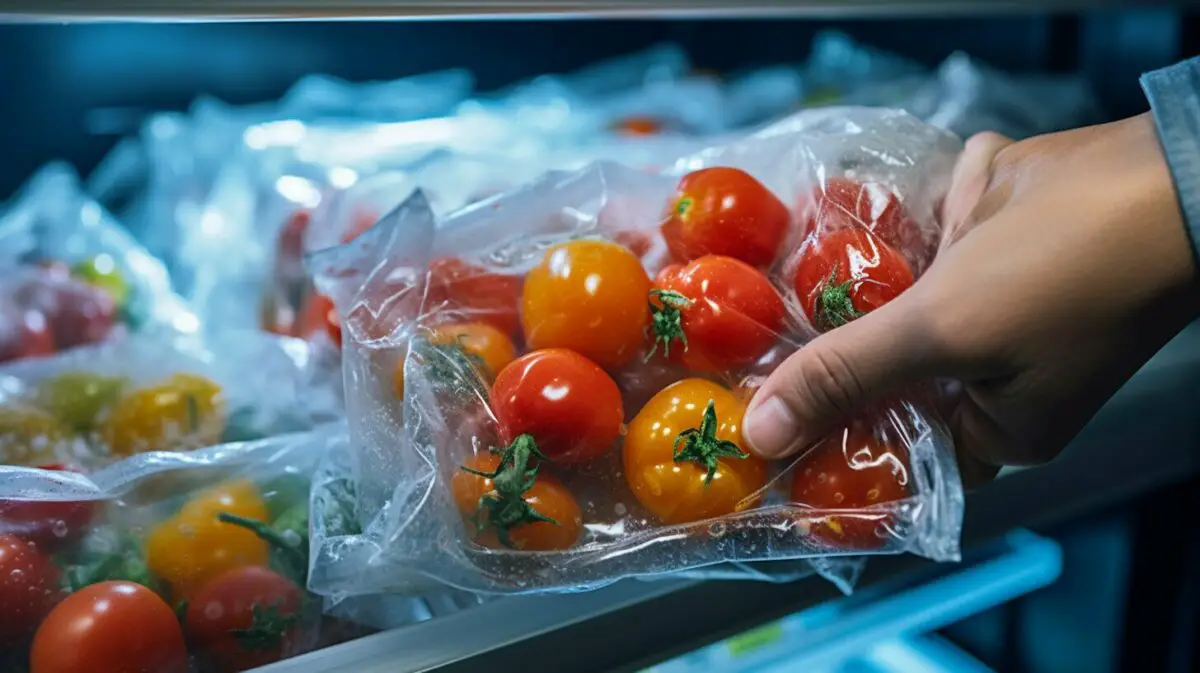
Now that your tomatoes are frozen, let’s talk about the best way to store them for long-lasting freshness. Proper storage is essential to maintain their flavor and quality. Here are a few tips to ensure your frozen tomatoes stay in great condition:
- Choose the right containers: Use freezer-safe containers or resealable freezer bags to prevent freezer burn and preserve the taste of the tomatoes.
- Label and date: Don’t forget to label your containers with the date of freezing. This will help you keep track of their freshness and use them in a timely manner.
- Portion control: Consider freezing tomatoes in small portions based on your cooking needs. This way, you can easily grab the desired amount without defrosting the whole batch.
- Remove excess air: When using freezer bags, squeeze out any excess air before sealing. This will help prevent freezer burn and keep the tomatoes in better condition.
- Proper storage temperature: Keep your frozen tomatoes at a constant temperature of 0°F (-18°C) or below. This will maintain their quality and prevent any spoilage.
By following these storage guidelines, you can enjoy the taste of summer tomatoes even during the colder months. Whether you’re making sauces, soups, or stews, these frozen gems will add a burst of flavor to your dishes.

| Storage Method | Duration |
|---|---|
| Freezer bags or airtight containers in the freezer | Up to 8 months |
| Deep freezer (-10°F / -23°C or below) | Up to 12 months |
Remember, the longer you keep the frozen tomatoes, the more they may lose their texture and freshness. It’s best to use them within the recommended storage durations for optimal taste. With proper storage, you can enjoy the delicious goodness of tomatoes all year round!
Cooking with Blanch Tomatoes
Now that you have a batch of blanched tomatoes on hand, get ready to elevate your culinary creations with their vibrant flavor. Blanching tomatoes not only makes them easier to peel, but it also enhances their taste and texture, making them perfect for a variety of recipes.
One classic way to use blanched tomatoes is in a homemade marinara sauce. Simply dice the peeled tomatoes and sauté them with garlic and onions in olive oil. Add your favorite herbs, such as basil and oregano, and let the sauce simmer to develop its rich flavors. Use this tomato sauce as a base for pasta dishes, pizza, or even as a dipping sauce for garlic bread.
If you’re in the mood for a refreshing summer salad, blanched tomatoes make a delightful addition. Combine them with juicy watermelon cubes, creamy feta cheese, and fresh mint leaves. Drizzle with a tangy vinaigrette made with lemon juice, olive oil, and a touch of honey. This vibrant salad is perfect for picnics or as a side dish for grilled meats.
| Recipes | Ingredients | Instructions |
|---|---|---|
| Marinara Sauce |
|
|
| Watermelon and Feta Salad |
|
|
With blanched tomatoes, the possibilities are endless. Whether you’re making a homemade salsa, a comforting tomato soup, or a flavorful curry, these blanched beauties will add a burst of freshness to your dishes. So get creative in the kitchen and let the vibrant flavor of blanch tomatoes shine in your culinary adventures!
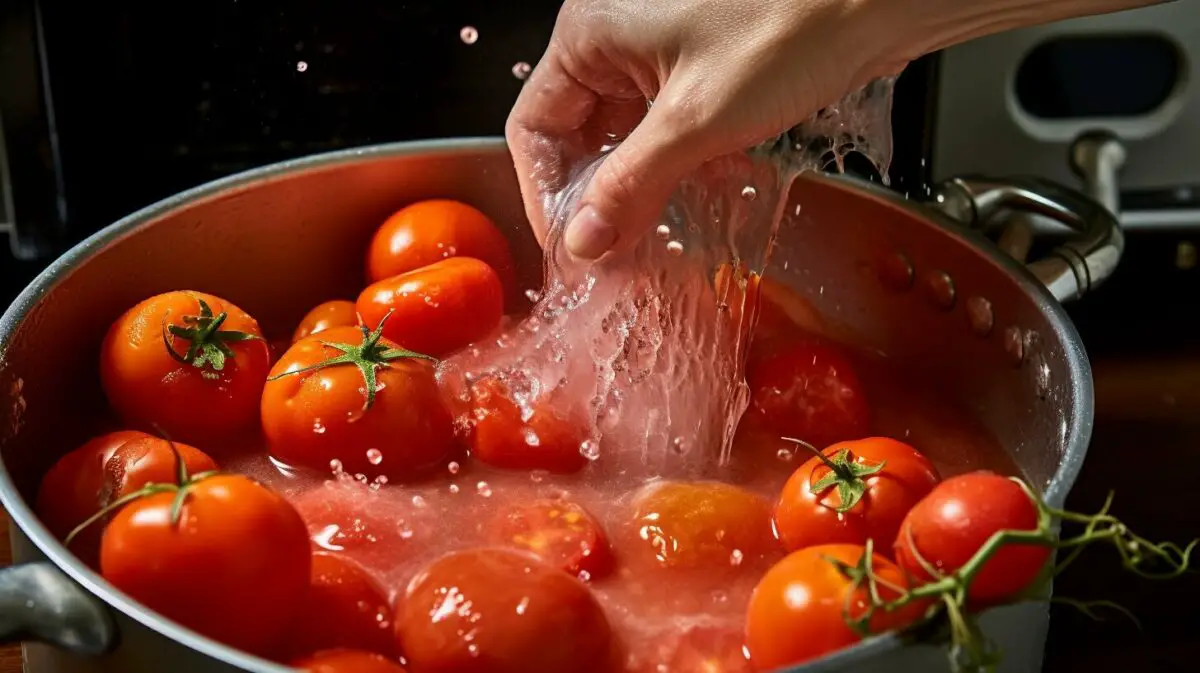
Need to convert measurements while blanching tomatoes? Let’s break it down for you.
When it comes to blanching tomatoes, accurate measurements are crucial to achieve the best results. Whether you’re following a recipe or experimenting with your own culinary creations, being able to convert measurements will help you add the right amount of ingredients and make your dish a success.
To convert measurements, keep these conversions in mind:
- 1 cup = 16 tablespoons = 48 teaspoons
- 1 tablespoon = 3 teaspoons
- 1 fluid ounce = 2 tablespoons
- 1 pound = 16 ounces
For precise conversions, use measuring cups and spoons. It’s also helpful to have a kitchen scale for weight measurements. Remember, accuracy is key to ensure your blanch tomatoes turn out just right!

| Measurement | Imperial | Metric |
|---|---|---|
| 1 cup | 16 tablespoons | 240 milliliters |
| 1 tablespoon | 3 teaspoons | 15 milliliters |
| 1 fluid ounce | 2 tablespoons | 30 milliliters |
| 1 pound | 16 ounces | 454 grams |
Tips and Tricks in the Kitchen
Want to become a blanching pro? Here are some expert tips and tricks to take your kitchen skills to the next level.
1. Choose Ripe and Firm Tomatoes
When blanching tomatoes, it’s important to select ripe and firm ones for the best results. Ripe tomatoes will have a brighter color and give slightly when gently pressed. Firm tomatoes are easier to handle during the blanching process and will hold their shape better.
2. Use a Timer
To ensure that you blanch the tomatoes for the optimal time, use a timer. Over blanching can cause the tomatoes to become mushy, while under blanching may make the skin difficult to peel. Set a timer for 30 to 60 seconds when submerging the tomatoes in boiling water and another timer for 30 seconds to 1 minute in the ice water bath.
3. Make an “X” Cut
Before blanching the tomatoes, make a small “x” cut at the bottom of each tomato. This will help the skin peel off easily after blanching. Use a sharp knife to make shallow cuts to avoid damaging the flesh of the tomato.
| Tips and Tricks | Benefits |
|---|---|
| 1. Choose ripe and firm tomatoes | – Brighter color and better texture |
| 2. Use a timer | – Consistent blanching results |
| 3. Make an “X” cut | – Easy skin peeling |
By following these tips and tricks, you’ll be able to blanch tomatoes like a pro, ensuring that the skin comes off effortlessly and preserving the flavor and texture of the fruit. Blanching tomatoes opens up a whole new world of culinary possibilities, from homemade sauces to flavorful soups and stews. So grab those tomatoes and start blanching!

Conclusion – How to Blanch Tomatoes
Congratulations! You have now mastered the art of blanching tomatoes, unlocking a world of culinary possibilities. With this simple technique, you can easily peel your tomatoes, making them more versatile and enjoyable in a wide range of recipes.
By following the step-by-step guide, you can ensure that your blanching process is efficient and effective. Start by preparing the tomatoes, washing them thoroughly and removing any soft or rotten spots. Trim the stems and make small incisions at the bottom of each tomato.
Next, bring a pot of water to a boil and prepare an ice water bath. Submerge the tomatoes in the boiling water for a short time and then quickly transfer them to the ice water bath. This rapid change in temperature will cause the skin to peel back, making it easy to remove.
Once the tomatoes have cooled, peel away the skin, starting from the incisions you made earlier. Dry them off and you’re ready to go. You can freeze the peeled tomatoes, storing them in the freezer for up to 8 months, ensuring you have delicious, blanched tomatoes on hand whenever you need them.
The beauty of blanching tomatoes is that it opens up a world of culinary possibilities. Whether you’re making sauces, soups, or stews, blanched tomatoes will add a burst of flavor and vibrant color to your dishes. Experiment with different recipes, get creative in the kitchen, and enjoy the delightful taste of perfectly blanched tomatoes.
FAQ – How to Blanch Tomatoes
Q: How do I blanch tomatoes?
A: Blanching tomatoes is a simple process. Start by washing the tomatoes under cold water and removing any soft or rotten spots. Trim the stems using a small knife or a stem remover. Cut a 1-inch “x” into the bottom of each tomato. Bring a large pot of water to a boil and prepare an ice water bath. Submerge the tomatoes in the boiling water for 30 to 60 seconds until the skin starts to peel back. Use a slotted spoon to remove the tomatoes and place them in the ice water bath for 30 seconds to 1 minute. Peel away the skin starting from the “x” immediately after drying. Finally, you can freeze the peeled tomatoes by placing them on cookie sheets and then transferring them to freezer bags. They can be stored in the freezer for up to 8 months.
Q: Why is blanching tomatoes important?
A: Blanching tomatoes is important because it makes it easier to peel off the skin. This can be useful when preparing recipes that require peeled tomatoes, such as tomato sauce or salsa. Blanching also helps to remove any residual dirt or bacteria on the skin.
Q: How should I prepare the tomatoes before blanching?
A: Before blanching, wash the tomatoes under cold water to remove any dirt or grime. Remove any soft or rotten spots on the tomatoes. Trim the stems using a small knife or a stem remover.
Q: What do I need to do to make incisions in the tomatoes?
A: To make incisions in the tomatoes, use a small, sharp knife. Cut a 1-inch “x” into the bottom of each tomato. This will help the skin to peel back during the blanching process.
Q: How do I boil water and create an ice bath for blanching tomatoes?
A: To boil water, bring a large pot of water to a rolling boil on the stovetop. To create an ice bath, fill a large bowl with water and add ice cubes. This will be used to quickly cool down the blanched tomatoes and stop the cooking process.
Q: What is the main blanching process for tomatoes?
A: The main blanching process for tomatoes involves submerging them in boiling water for a short period. This helps to loosen the skin and make it easier to peel off.
Q: How can I easily peel the blanched tomatoes?
A: After blanching and transferring the tomatoes to an ice water bath, peel away the skin starting from the “x” on the bottom. The skin should easily come off, leaving you with peeled tomatoes.
Q: Can I freeze the peeled tomatoes?
A: Yes, you can freeze the peeled tomatoes. Place them on cookie sheets in a single layer and then transfer them to freezer bags. They can be stored in the freezer for up to 8 months.
Q: How should I store the frozen tomatoes?
A: To store frozen tomatoes, place them in freezer bags, ensuring all the air is removed to prevent freezer burn. Label the bags with the date and contents. Store them in the freezer for up to 8 months.
Q: What are some ways to cook with blanched tomatoes?
A: Blanched tomatoes can be used in a variety of recipes. You can make tomato sauce, salsa, tomato soup, or use them in pasta dishes, stews, or salads. The possibilities are endless!
Q: How do I convert measurements when blanching tomatoes?
A: If you need to convert measurements when blanching tomatoes, there are various online conversion tools or charts that can help you with this. You can easily convert between different units of measurement, such as cups, ounces, or grams.
Q: Do you have any additional tips and tricks for blanching tomatoes?
A: Absolutely! One tip is to use ripe tomatoes for blanching, as they will be easier to peel. It’s also helpful to work in batches when blanching a large quantity of tomatoes. And don’t forget to label and date your freezer bags when storing the peeled tomatoes.
Our Friends
- https://www.oliviascuisine.com/how-to-peel-tomatoes/
- https://www.masalaherb.com/blanch-tomatoes-to-peel/
- https://www.wikihow.com/Blanch-Tomatoes
Related Recipes:
 How to Cut a Tomato? (Perfect Step-By-Step Guide)
How to Cut a Tomato? (Perfect Step-By-Step Guide)
 How Many Tomatoes in a Pound? (Perfect Measurement Conversion Guide)
How Many Tomatoes in a Pound? (Perfect Measurement Conversion Guide)
 How to Freeze Broccoli? (Essential Step-By-Step Guide)
How to Freeze Broccoli? (Essential Step-By-Step Guide)
 How to Cut a Kiwi? (Perfect Step-By-Step Guide)
How to Cut a Kiwi? (Perfect Step-By-Step Guide)
 How to Cut Avocados? (Perfect Step-By-Step Guide)
How to Cut Avocados? (Perfect Step-By-Step Guide)
 How to Cut Beets? (Perfect Step-By-Step Guide)
How to Cut Beets? (Perfect Step-By-Step Guide)
 How to Cook Asparagus? (5-Way Step-By-Step Guide)
How to Cook Asparagus? (5-Way Step-By-Step Guide)
 How to Make Basil Oil? (Perfect Step-by-Step Guide)
How to Make Basil Oil? (Perfect Step-by-Step Guide)


